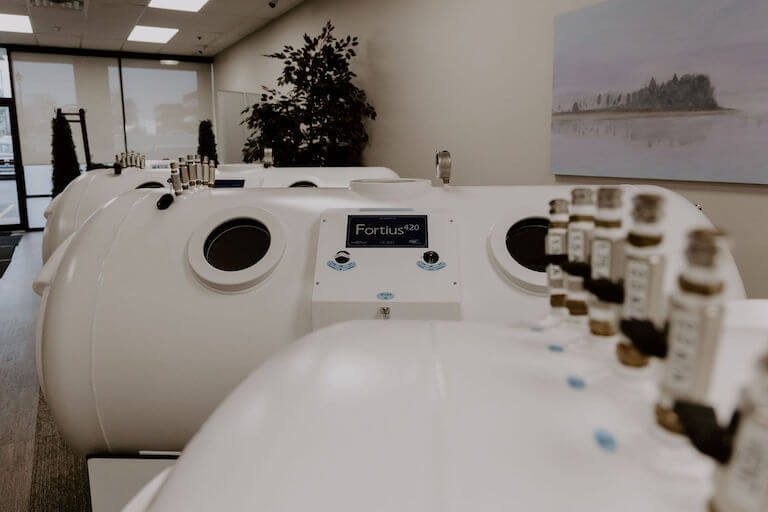Why Hyperbaric Oxygen Therapy is a Promising Option for Dementia Patients
In the US and worldwide, dementia stands as a significant challenge affecting millions. In 2022, over 6.5 million individuals aged 65 and older were grappling with Alzheimer’s disease (AD) in the US alone [2]. This statistic underscores the urgent need for effective treatments and holistic care approaches.
Hyperbaric Oxygen Therapy (HBOT) is emerging as a newly recognized tool for dementia patients for its unique approach to enhancing brain health. HBOT involves the inhalation of pure oxygen in a pressurized environment, typically within a specialized chamber. This innovative therapy increases blood oxygen saturation, allowing for higher levels of oxygen to be delivered to vital organs and tissues, including the brain.
This blog explores the potential of Hyperbaric Oxygen Therapy (HBOT) as a holistic approach to dementia care. We will look into how this unique therapy works, its benefits for dementia patients, and how it can be integrated with functional medicine practices to enhance overall well-being and cognitive function.
How Hyperbaric Oxygen Therapy Works
At its core, HBOT is about enhancing the body’s natural healing process through oxygen. By breathing in pure oxygen at pressures higher than atmospheric pressure, patients’ lungs can absorb more oxygen than under normal conditions. This oxygen-rich blood circulates throughout the body, infusing into tissues that may be receiving inadequate levels of oxygen. For those suffering from dementia, this means a direct boost to brain function, potentially slowing cognitive decline and enhancing overall brain health.
Benefits for Dementia Patients
The increased oxygen delivery can have several benefits for dementia patients:
- It may stimulate the growth of new blood vessels in the brain, improving blood flow and oxygenation to areas that are deficient.
- HBOT can reduce inflammation and swelling, potentially alleviating symptoms associated with dementia.
- There’s potential for HBOT to encourage the repair of damaged brain cells and stimulate the formation of new neural connections.
For a deeper understanding of Hyperbaric Oxygen Therapy on a cellular level, check out our blog here.
Understanding the Complex Disease of Dementia

Dementia is not a single disease but a term that covers a wide range of specific medical conditions, including Alzheimer’s disease and more. Each type of dementia can present with a range of symptoms and cognitive impairments.
Common Types of Dementia
- Alzheimer’s Disease (AD): AD is the most common cause of dementia, accounting for 60-80% of cases. A progressive decline in cognitive function, memory loss, and changes in behavior and mood characterize it. The deterioration of brain cells in AD leads to the hallmark symptoms of memory impairment and difficulties with thinking, problem-solving, and language.
- Vascular Dementia (VD): VD is the second most common type of dementia. It results from reduced blood flow to the brain, often due to stroke or other cardiovascular conditions. VD can lead to various cognitive and functional impairments, depending on the affected brain areas.
- Lewy Body Dementia (LBD): LBD is characterized by abnormal protein deposits called Lewy bodies in the brain. Patients with LBD may experience cognitive decline, fluctuating alertness, and visual hallucinations, along with movement disorders similar to Parkinson’s disease.
- Frontotemporal Dementia (FTD): FTD refers to a group of disorders affecting the frontal and temporal lobes of the brain. This can lead to changes in personality, behavior, and language skills, as well as a gradual deterioration in cognitive function.
- Mixed Dementia: Sometimes, individuals may be diagnosed with more than one type of dementia, such as AD and VD. This leads to a mixed dementia diagnosis, which can present with symptoms characteristic of multiple dementia types.
Risk Factors for Developing Dementia
Several factors contribute to the risk of developing dementia. Age is the most significant risk factor, with the prevalence of dementia increasing notably after 65 years of age. Genetics, family history, cardiovascular health, lifestyle factors like diet and physical activity, cognitive engagement, and social interaction levels also play crucial roles. Addressing modifiable factors, such as lifestyle and cognitive engagement, can potentially reduce the risk of developing dementia.
Treatment and Management
The management of these types of dementia often involves a combination of pharmacological and non-pharmacological interventions. While current treatments primarily focus on alleviating symptoms and improving quality of life, there is growing interest in exploring therapies like Hyperbaric Oxygen Therapy (HBOT) that could potentially slow the progression of the disease and improve cognitive function.
In the subsequent sections, we will explore how Hyperbaric Oxygen Therapy, along with functional medicine practices, can provide a holistic approach to improving the quality of life for dementia patients, potentially addressing some of the underlying causes of cognitive decline.
How Hyperbaric Oxygen Therapy Can Improve Dementia Symptoms and Increase Quality of Life
Research indicates that Hyperbaric Oxygen Therapy (HBOT) can significantly boost cognitive function in dementia patients, as evidenced by improved scores on the Mini-Mental State Examination (MMSE). This improvement not only suggests a potential reversal or slowing of cognitive decline but also extends to enhancing daily living activities. Patients receiving HBOT demonstrate notable improvements in their ability to carry out everyday tasks, signaling an uplift in their overall quality of life.
A key aspect of HBOT’s effectiveness lies in its impact on cerebral microcirculation. By enhancing blood flow at the microcirculation level, the therapy facilitates better oxygenation of brain tissues. This improvement is particularly vital in addressing the progression of vascular dementia and other cognitive impairments. Moreover, patients undergoing HBOT have shown elevated levels of serum Humanin, a protein linked to improved cognitive functions, further underscoring the therapy’s potential in managing dementia symptoms.
HBOT’s role in increasing oxygen tension and tissue oxygen levels is another critical factor in its therapeutic effects. By elevating oxygen availability in the brain, the therapy addresses significant challenges in dementia, such as reduced cerebral blood flow and oxygenation. This increase in oxygenation can lead to a decrease in intracranial pressure and relief from cerebral edema. Consequently, dementia patients undergoing HBOT often experience symptomatic relief, contributing to an enhanced state of cognitive and physical well-being.
Our Patient-Centered Approach to Dementia Care at Hyperbaric Wellness Center
At Hyperbaric Wellness Center, we understand the complexities of dementia and its profound impact on both patients and their families. Our approach to dementia care is patient-centered, focusing on personalized treatments that address the unique needs of each individual. Here’s an inside look at how we tailor our approach to enhance the cognitive function and overall well-being of our dementia patients:
- Individualized Treatment Plans: We believe in the uniqueness of each patient’s journey with dementia. Our treatment plans are personalized, involving an in-depth understanding of each patient’s medical history, lifestyle, and specific challenges.
- Advanced Diagnostics with AO Scan: To ensure precise and effective treatment, we employ advanced diagnostic tools like AO Scan. This technology helps us understand the specific needs of each patient, allowing us to tailor our therapies more accurately.
- Addressing Nutritional Deficiencies: Nutrition plays a crucial role in brain health. We focus on identifying and addressing any nutritional deficiencies that may be impacting cognitive function. Our dietary plans are designed to support brain health and overall well-being.
- Hyperbaric Oxygen Therapy (HBOT): As a cornerstone of our treatment approach, HBOT is used to enhance cerebral oxygenation. This therapy has shown potential in improving cognitive function and slowing the progression of symptoms in dementia patients.
- Theta Chamber for Cognitive Enhancement: Alongside HBOT, we utilize state-of-the-art therapies like the Theta Chamber. This therapy is designed to promote relaxation and improve neurological function, contributing to better cognitive health.
- Continuous Monitoring and Adjustment: Our care for dementia patients is dynamic. We continuously monitor the progress and adapt our treatments as needed, ensuring that each patient receives the most effective care throughout their journey with us.
At Hyperbaric Wellness Center, our goal is to enhance the quality of life for dementia patients through our comprehensive and patient-centered approach.
Conclusion: Embracing a New Horizon in Dementia Care
It’s becoming increasingly clear that Hyperbaric Oxygen Chamber Therapy can play a pivotal role in the future of dementia care. By improving cognitive function, enhancing daily living abilities, and potentially reversing some symptoms, HBOT offers a ray of hope for those affected by this challenging condition.
Integrating HBOT with functional medicine practices that focus on personalized care, dietary interventions, and family involvement provides a comprehensive approach to dementia care. This holistic perspective goes beyond treating symptoms, aiming to enhance the overall quality of life for those living with dementia.
At Hyperbaric Wellness Center, we’re committed to exploring these new frontiers in healthcare. If you or a loved one are facing the challenges of dementia, we invite you to discover how Hyperbaric Oxygen Therapy can make a difference.
Contact us today to schedule a free consultation and take the first step towards a brighter, healthier future in dementia care.
Resources:
Alves, S. (2018). Enabling Biographical Cognitive Stimulation for People with Dementia. https://www.semanticscholar.org/paper/0612562df50ad8a484306719600a17f833826d12
Balasubramanian, P., DelFavero, J., Nyúl‐Tóth, Á., Tarantini, A., Gulej, R., & Tarantini, S. (2021). Integrative role of hyperbaric oxygen therapy on Healthspan, Age-Related vascular Cognitive impairment, and dementia. Frontiers in Aging, 2. https://doi.org/10.3389/fragi.2021.678543
Dhana, K., Beck, T., Desai, P., Wilson, R. S., Evans, D. A., & Rajan, K. B. (2023). Prevalence of Alzheimer’s disease dementia in the 50 US states and 3142 counties: A population estimate using the 2020 bridged‐race postcensal from the National Center for Health Statistics. Alzheimer’s & Dementia, 19(10), 4388–4395. https://doi.org/10.1002/alz.13081
Launer L. J. (2019). Statistics on the burden of dementia: need for stronger data. The Lancet. Neurology, 18(1), 25–27. https://doi.org/10.1016/S1474-4422(18)30456-3
Maestre, G. E., Carrillo, M., Kalaria, R. N., Acosta, D., Adams, L. D., Adoukonou, T., Akinwande, K. S., Akinyemi, J., Akinyemi, R., Akpa, O. M., Alladi, S., Allegri, R., Arizaga, R. L., Arshad, F., Arulogun, O., Babalola, D. O., Baiyewu, O., Bak, T. H., Bellaj, T., . . . Author_Id, N. (2023). The Nairobi Declaration—Reducing the burden of dementia in low‐ and middle‐income countries (LMICs): Declaration of the 2022 Symposium on Dementia and Brain Aging in LMICs. Alzheimer’s & Dementia, 19(3), 1105–1108. https://doi.org/10.1002/alz.13025
Motzek, T., Werblow, A., Schmitt, J., & Marquardt, G. (2018b). Administrative Prävalenz und Versorgungssituation der Demenz im Krankenhaus – Eine versorgungsepidemiologische Studie basierend auf GKV-Daten sächsischer Versicherter. Gesundheitswesen, 81(12), 1022–1028. https://doi.org/10.1055/s-0043-125071
Pierce, D. (2019). Functional Contentment Model: Optimizing Quality of Life for Nursing Home Residents with Dementia. https://www.semanticscholar.org/paper/7e3fc077740d4297105f21cfeba6d3337710dc05
Qin, Y., Li, L., Xiong, S., Yan, Y., Li, D., Yan, N., Chen, H., & Liu, Y. (2019). Meta-Analysis on the efficacy and safety of hyperbaric oxygen as adjunctive therapy for vascular dementia. Frontiers in Aging Neuroscience, 11. https://doi.org/10.3389/fnagi.2019.00086
Xu, Y., Wang, Q., Qu, Z., Yang, J., Zhang, X., & Zhao, Y. (2019). Protective Effect of Hyperbaric Oxygen Therapy on Cognitive Function in Patients with Vascular Dementia. Cell Transplantation, 28(8), 1071–1075. https://doi.org/10.1177/0963689719853540


